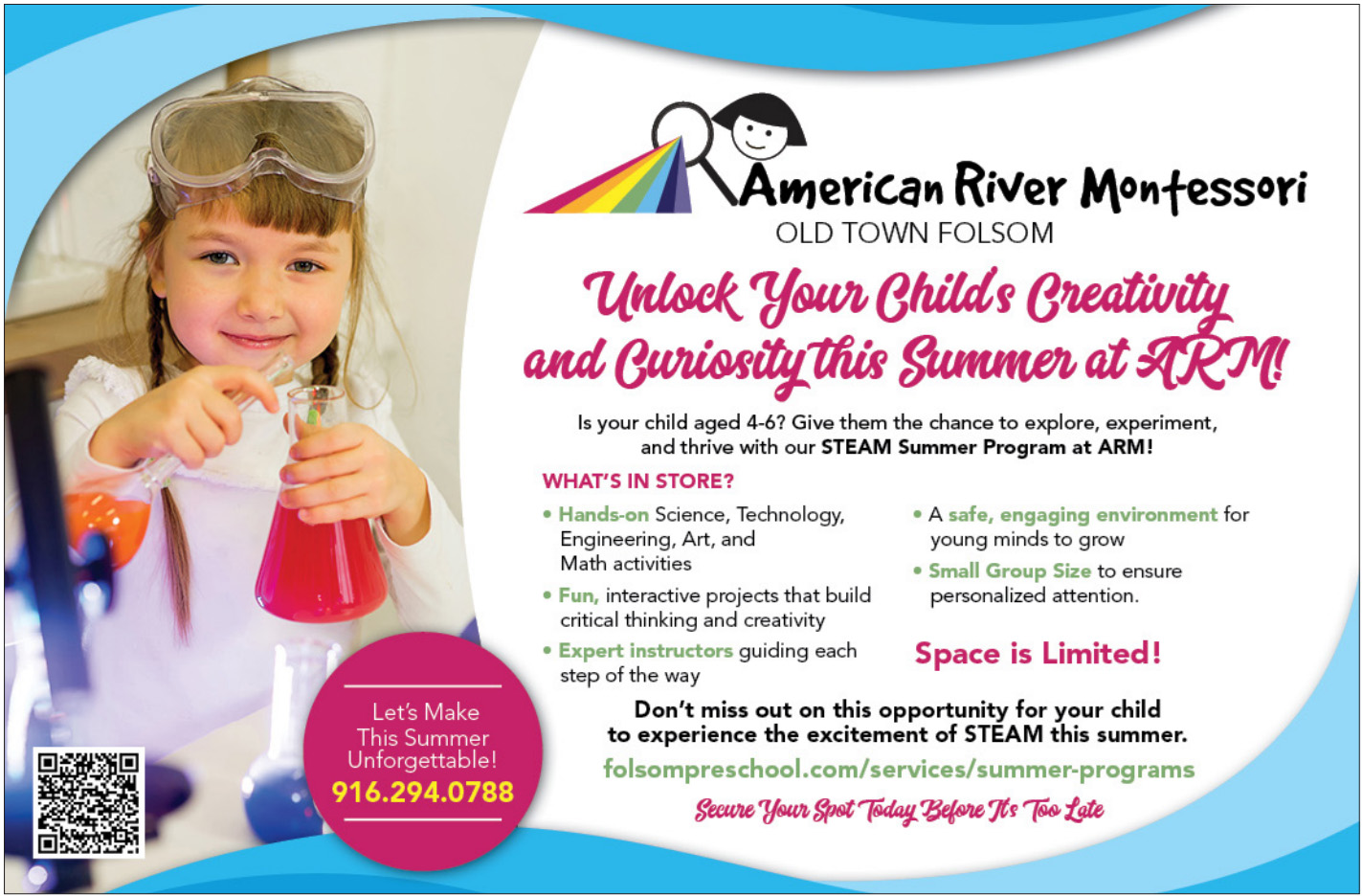American River
Montessori
- "Free the child's potential, and you will transform him into the world"
- -Maria Montessori

Welcome
We are a small school with a mixed-aged classroom. We educate toddlers as well as children in Preschool, Pre-Kindergarten, and Kindergarten.
Additionally, we provide tutoring services for Pre-K through 6th Grade, a variety of academic camps and kids’ activities each summer and special community events.
Please explore this website to learn more about our services and to schedule a visit today.
We look forward to hearing from you!
Call Deb at 916.294.0788 or 916.257.0589
401 Mormon Street, Folsom, CA 95630
Our fundamentals
Our Vision:
Working as a community, we as educators and parents work together to prepare each child to embrace and contribute to a better world.
Our Mission:
Create positive supportive environments to plant the seeds of quality interactions that support positive child brain development, love of learning and curiosity for success in the world.
Our Graduates Are:
- Empathetic towards their peers
- Problem solvers
- Independent and eager learners
- Role models in the classroom
- They are resilient.
- Critical Thinkers
- Reflective
- Growth mindset
- Creative
- Confident in expressing ideas
Our Latest Posts
View our latest posts from American River Montessori below






Our Outdoor Classroom
Our brand new for 2025 outdoor classroom evolves with the seasons and includes a garden where children can learn about growing things outdoors.

What our Students and Parents Think



American River Montessori supported my daughter, Sophia, in developing strong math skills. For example, she was already learning multiplication before she entered Kindergarten. When Sophia was evaluated in Kindergarten it was clear that her understanding of math concepts was advanced. I believe my daughter developed the self-confidence for math that continues to inspire her as she learns even more advanced math concepts, because of her experience at American River Montessori. I would recommend American River Montessori’s Math Program, because I know that Ms. Debbie is committed to providing a positive environment where children want to learn more.
Kathy Sumimoto
My children have attended American River Montessori for over 2 years in the Preschool, Pre-Kindergarten and Kindergarten programs. My children spent time in other schools that weren’t the right fit for our family. When we walked into Ms. Debbie’s welcoming, bright, and peaceful classroom, we fell in love with Montessori education. Everywhere you look, children are happy and busy working independently, with friends, and with teachers on interesting jobs and projects of their choosing. Ms. Debbie recognizes each child’s needs and interests, and encourages them to work at their own pace, do their best, and communicate well with friends. There is a strong sense of community between staff and families. The children get along very well because of how Ms. Debbie models and teaches caring behavior. She gives the children freedom to explore the fun and meaningful jobs. She makes sure the children are getting what they need academically, socially, and emotionally. I am so thankful I found this school. My children look forward to going to school each day. They have a strong love of learning and they are well prepared for elementary school, thanks to their time at American River Montessori.
Amber
parent and teacherOur daughter, Addie, attended American River Montessori from 2013-2015. When searching for a preschool, we wanted an engaging and caring classroom environment that provided meaningful learning activities. We wanted to know our daughter was in a safe place where the teachers cared about her and met her individual needs. We found exactly what we wanted for our daughter at American River Montessori. Ms. Debbie does an amazing job in providing a learning environment that educates the whole child. She has a natural ability to recognize teachable moments that help students learn problem solving skills. While under Ms. Debbie’s guidance, my daughter progressed into an independent and confident student. Addie is resourceful, a problem solver, and a leader. We believe Ms. Debbie’s school prepared her for kindergarten and gave her the academic, social, and emotional skills needed for elementary school and beyond.
Brian and Amy Enquist
American River Montessori is amazing. My sons learned so much while attending the school. The teachers are calm, educated, and uplifting. My kids were always bringing back artwork, showing me dance moves, counting to 100 and more. I cannot believe the progression in just a few months. I highly recommend this school to anyone who wants the best for their little one while they are at work.
Clint
My first born went to Ms. Debbie school for pre-k at 3 years of age. She is 9 and she still says Ms. Debbie and American River Montessori are the best teacher and school she has attended. I agree. The dedication and one on one attention given to the children is unmatched in other places. And the quality of the education is excellent. Sofia reads at a 7th grade level at her age and math is a breeze. She learned hands on with the real life activities and experiences offered. Debbie spent all the time needed with me and the parents to explain about our kids’ progress in every aspect of human development and learning. Yoga in the middle of the day? Yep. That too.
Andrea
I originally chose the preschool after observing and meeting with the owner, Debbie Doss. She is welcoming, knowledgeable, and has an obvious love of children and teaching. Her Montessori materials are impressive and are constantly being rotated throughout the school year. My daughter, Kaylie, was a student in American River Montessori for 2 ½ years. During her time in the school, I witnessed her enthusiasm and love for learning deepen. When she first started preschool, Kaylie watched the older kids doing advanced concepts and she strived to do those too. Once, she got older she continued to push herself to learn even higher concepts. Her intrinsic interest in her own learning began in preschool and continues to deepen in elementary school. She is now 7 years old and is supposed to be in second grade, but because of her advanced academic abilities she has been placed in a third grade classroom and is doing third and fourth grade curriculum. Kaylie is so proud of her knowledge and she is dedicated to continuing to learn more and more. At home and at school, Kaylie continues to soar academically, socially, and emotionally.
Sara Smith
Parent and Teacher






